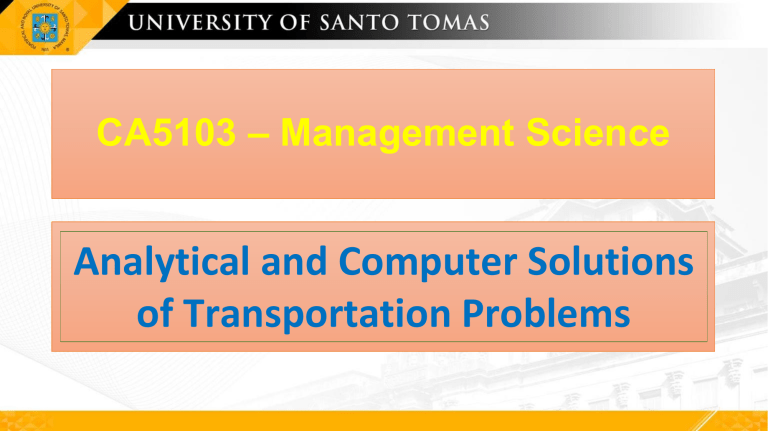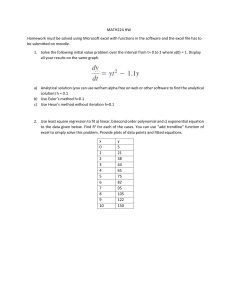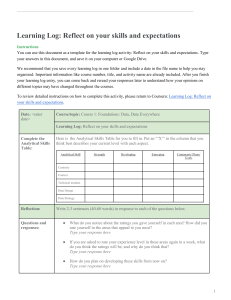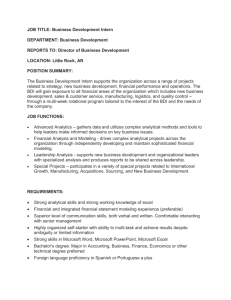
CA5103 – Management Science Analytical and Computer Solutions of Transportation Problems Learning Objectives: At the end of this module, the students should be able to: 1. Identify the different methods used in finding the analytical solution of transportation problems; 2.Solve transportation problems using the Northwest Corner Rule, Least Cost Method and Modified Distribution and; 2.Solve transportation and transshipment problems using the Excel Solver. Determination of a Starting Feasible Solution (Uy et al., 2013) The general definition of the transportation model requires that: Note: A starting basic feasible solution must include m + n -1 basic variables (known as the Rim Requirement). Analytical Solution of Transportation Problem ❑ Northwest Corner Method (NWC) - provides a straightforward technique for obtaining the initial solution (systematic, easily understandable method) - the costs are not relevant in determining the initial solution Listed below are the steps to find the initial basic feasible solution (Uy et al., 2013) : 1. Starting with the northwest most (upper left hand) corner, allocate the smaller amount of either the row supply or the column demand thereby exhausting the supply and demand requirements. Analytical Solution of Transportation Problem 2.Subtract from the row supply and from the column demand the amount allocated. If the column demand is now zero, move to the cell next on the right; if the row supply is zero, move down the cell in the next row. If both are zero, move first to the next cell on the right, place 0, then down one cell. 3. Once a cell is identified ass per step 2, it becomes the new northwest cell. Allocate an amount as in step 1. 4. Repeat the above steps 1 to 3 until all remaining supply and demand is gone. Analytical Solution of Transportation Problem Example 1: Find the initial basic feasible solution using the Northwest corner method. (Note: Consider the Acme Block Company transportation problem below.) Northwood Westwood Eastwood To Plant From Supply 40 24 30 40 Plant 1 40 30 40 42 Plant 2 80 Demand 25 45 10 80 Analytical Solution of Transportation Problem Example 1 (using NWC): To Northwood Westwood Eastwood From Plant 1 Plant Supply 40 25 40 Plant 2 80 Demand 25 45 10 80 Step 1 : Begin in the upper left hand corner of the table by allocating the 25 units of resources (smaller amount of either row supply or column demand) to exhaust the requirements. Analytical Solution of Transportation Problem Example 1 (using NWC): To Northwood Westwood Eastwood From Plant 1 25 Plant Supply 40 15 40 Plant 2 80 Demand 25 45 10 80 Step 2 and Step 3 : Subtract 25 from the row supply in Plant 1 (40) and allocate the said amount of resources (15) of Plant 1 to Westwood. Note: The resources in row 1 are fully allocated (exhausted). Analytical Solution of Transportation Problem Example 1 (using NWC): To Northwood Westwood Eastwood From Plant 1 25 40 15 30 Plant 2 Plant Supply 40 Step 4: Repeat steps 1 to 3 until all resources are exhausted and all requirements are satisfied. 10 80 Demand 25 45 10 80 Note that a solution becomes basic if the number of occupied cells, i.e. cells with allocations is m+n-1, where m represents the number of rows and n, the number of columns (if m = 2 and n = 3 then m+n-1 = 4, thus the basic feasible solution must include 4 basic variables). Analytical Solution of Transportation Problem Example 1 (using NWC): To Northwood Westwood Eastwood From 24 25 Plant 1 30 30 15 40 30 Plant 2 Plant Supply 40 40 42 40 10 80 Demand 25 45 10 80 Z = 24 (25) + 30 (15) + 40 (30) + 42 (10) = 2670 The total cost in this solution is obtained by multiplying the cells allocation to the shipping cost per unit. Analytical Solution of Transportation Problem Example 2: Find the initial basic feasible solution using the Northwest corner method. Transportation Destination Transportation Government W1 W2 W3 Mode Regulations Truck 12 6 5 3000 Railroad 20 11 9 3000 30 26 28 Airplane Material Requirements 3000 9000 4000 2500 2500 9000 Analytical Solution of Transportation Problem Example 2 ( using NWC): Transportation Mode W1 Truck 12 Railroad 20 Airplane 30 Material Requirements 3000 1000 Destination W2 6 11 26 2000 500 W3 Transportation Government Regulations 5 3000 9 3000 28 3000 2500 9000 4000 2500 2500 9000 Z = 12 (3000) + 20 (1000) + 11 (2000) + 26 (500) + 28 (2500) = 161,000 Analytical Solution of Transportation Problem ❑ Least Cost (Minimum Cell) Method - involves sequentially allocating the resources to the cells with the minimum cost to obtain the initial solution Here are the steps to find the initial basic feasible solution (Uy et al., 2013) : 1. Select the cell with the lowest available cost. Allocate as much as possible in view of the capacity of its row and the destination requirement of its column. 2. Choose the next lowest-cost cell and make an allocation in view of the remaining capacity and requirement of its row and column. 3. Repeat the process until all remaining supply and demand is exhausted. Analytical Solution of Transportation Problem The Least Cost Method (LCM) yields not only an initial feasible solution but also one that is close to optimal in small transportation problems. This method is “heuristic” in nature. Note: If there is a tie for a lowest-cost cell during any allocation, we may choose any of these cells for allocation. If a single allocation exhaust the capacity of a row and satisfies the requirement of a column, we place a zero in one of the bordering cells (Uy et al., 2013). Analytical Solution of Transportation Problem Example 1 (using LCM): Northwood Westwood Eastwood Plant 1 24 30 40 Plant Supply 40 Plant 2 30 40 42 40 To From Demand 25 25 45 10 80 80 Step 1: Select the cell with the least cost and allocate the shipment to exhaust either the supply of plants or meet the demand requirements. Note that the lowest cost is 24 (in cell Plant 1 to Northwood). Analytical Solution of Transportation Problem Example 1 (using LCM): Northwood Westwood Eastwood Plant 1 24 30 40 Plant Supply 40 Plant 2 30 42 40 To From Demand 25 15 40 25 45 10 80 80 Step 2 : Choose the next lowest cost cell (with cost of 30) then make allocation of 15 units of resources meeting all the supplies in Plant 1. Analytical Solution of Transportation Problem Example 1 (using LCM): Northwood Westwood Eastwood Plant 1 24 30 40 Plant Supply 40 Plant 2 30 42 40 To From Demand 25 15 40 25 30 45 10 10 80 80 Step 3 : Repeat the process until all remaining supply and demand is exhausted. The total transportation cost: Z = 24 (25) + 30 (15) + 40 (30) + 42 (10) = 2670 Analytical Solution of Transportation Problem Example 2: Find the initial basic feasible solution using the Least Cost method. Transportation Mode W1 Destination W2 W3 Transportation Government Regulations Truck 12 6 5 3000 Railroad 20 11 9 3000 Airplane 30 26 28 3000 Material Requirements 9000 4000 2500 2500 9000 Analytical Solution of Transportation Problem Example 2 ( using LCM): Transportation Mode W1 Truck 12 Railroad 20 Airplane 30 Material Requirements Destination W2 6 1000 3000 11 500 2000 26 W3 5 Transportation Government Regulations 3000 2500 9 3000 28 3000 9000 4000 2500 2500 9000 Z = 5 (2500) + 6 (500) + 11 (2000) + 20 (1000) + 30 (3000) = 147,500 Analytical Solution of Transportation Problem ❑ Modified Distribution (MODI) Method (Uy et al., 2013) - an evaluation procedure used to examine if it is more desirable to move a shipment into one of the unused cells - aims to determine whether a better schedule of shipments from plants to warehouses can be developed - used to compute improvement indices for each unused cell without drawing all of the closed paths Analytical Solution of Transportation Problem The steps to find the initial basic feasible solution are as follows (Uy et al., 2013) : 1. For each solution, compute the R and K values for the occupied or used cells in the table using the formula: Ri + Kj = Cij where R1 is always set to 0. 2. Calculate the improved indices for all empty or unused cells using: Improvement index: Iij = Cij – (Ri + Kj) 3. Select the unused cell with the largest negative index. Note: If all indices are equal to or greater than zero, the solution is optimal. Analytical Solution of Transportation Problem 4. Trace the close path for the unused cell having the largest negative index. 5. Develop an improved solution. 6. Repeat steps 1 to 5 until an optimal solution has been found. Analytical Solution of Transportation Problem Example 1 (using MODI): To Northwood Westwood Eastwood 24 40 From 25 Plant 1 30 30 15 40 30 Plant 2 Plant Supply 40 42 40 10 80 Demand 25 45 10 80 Step 1 : Begin with the same initial solution obtained using NWC. To compute for R and K values, consider the occupied or used cells. Note that there are four occupied cells (Plant 1 to Northwood, Plant 1 to Westwood, Plant 2 to Westwood and Plant 2 to Eastwood). Analytical Solution of Transportation Problem Example 1 (using MODI): To Northwood Westwood Eastwood 24 40 From 25 Plant 1 30 30 15 40 30 Plant 2 Plant Supply 40 42 40 10 80 Demand 25 45 10 80 Step 1 : Begin with the same initial solution obtained using NWC. To compute for R and K values, consider the occupied or used cells. Note that there are four occupied cells (Plant 1 to Northwood, Plant 1 to Westwood, Plant 2 to Westwood and Plant 2 to Eastwood). Analytical Solution of Transportation Problem With four occupied cells (using Cij = Ri + Kj), the following are obtained: 24 = R1 + K1; 30 = R1 + K2; 40 = R2 + K2 and; 42 = R2 + K2 Since R1 is assumed equal to zero, then R2= 10; K1= 24; K2= 30; K3= 32; Step 2 : After the row and column values are computed, the next step is to evaluate each unused/ unoccupied cells by computing their improvement indices using Iij = Cij – (Ri + Kj). Thus, I13 = C13 – (R1 + K3) and I21 = C21 – (R2 + K1) are computed. Note that there are two unused cells in the problem and their improvement indices are: I13 = 8 and I21 = -4. Analytical Solution of Transportation Problem Step 3: Since the improvement index in the unused cell (row 2 to column 1) is negative (I21 = -4), the solution in not yet optimal. Step 4 and Step 5: Develop a new improved solution by tracing a close path for the cell having the largest negative index (I21 = -4). This is done by placing plus and minus signs at alternate corners of the path, beginning with a plus sign at the unused cell (row 2 to column 1). The smallest number in a negative position in the close path indicates the quantity that can be assigned to the unused cell being entered in the solution. This quantity is added to all cells in the close path with plus sign and subtracted from those cells with minus signs. Analytical Solution of Transportation Problem Example 1 (using MODI): To Northwood Westwood Eastwood 24 40 40 42 40 From Plant 1 - 30 Plant 2 25 30 15 + 40 + 30 - Plant Supply 10 80 Demand 25 45 S-smallest number in a negative position in the close path; 10 80 Ce cell having the largest negative index I21 = -4 Analytical Solution of Transportation Problem Example 1 (using MODI): To Northwood Westwood Eastwood 24 30 40 40 30 40 42 40 From 40 Plant 1 Plant 2 25 5 Plant Supply 10 80 Demand 25 45 10 80 Note that the table shows the results of adding and subtracting the smallest number (25) in a negative position in the close path to quantities with plus and negative signs, respectively. Step 6: Evaluate now the unused cells in this new solution and repeat the process until all indices are equal to or greater than zero. Analytical Solution of Transportation Problem The evaluation of each used and unused cells of the second solution is shown below: With four occupied cells (using Cij = Ri + Kj), the following are obtained: 30 = R1 + K2; 30 = R2 + K1; 40 = R2 + K2 and; 42 = R2 + K3 Since R1 is assumed equal to zero, then R2= 10; K1= 20; K2= 30; K3= 32; Now, evaluating the two unused cells in the problem by computing their improvement indices using Iij = Cij – (Ri + Kj) leads to I11 = 4 and I13= 8. Since all improvement index values are either zero or positive, the solution is optimal. Analytical Solution of Transportation Problem Example 1 (using MODI): To Northwood Westwood Eastwood 24 30 40 40 30 40 42 40 From 40 Plant 1 Plant 2 25 5 Plant Supply 10 80 Demand 25 45 10 80 Thus, the minimum cost is Z = 30 (40) + 30 (25) + 40 (5) + 42 (10) = 2570 Analytical Solution of Transportation Problem Example 2:Use MODI method to determine the optimal allocation of the given transportation.(Note: Consider the initial solution obtained in LCM) Transportation Mode W1 Destination W2 W3 Transportation Government Regulations Truck 12 6 5 3000 Railroad 20 11 9 3000 Airplane 30 26 28 3000 Material Requirements 9000 4000 2500 2500 9000 Analytical Solution of Transportation Problem Example 2 (using MODI): Transportation Mode W1 Destination W2 Truck 12 Railroad 20 11 Airplane 30 26 Material Requirements 1000 3000 6 2000 500 W3 Transportation Government Regulations 5 3000 9 3000 2500 3000 28 9000 4000 2500 2500 9000 Z = 12 (1000) + 6 (2000) + 11 (500) + 9(2500) + 30 (3000) = 142,000 Excel Solution of Transportation Problem The steps in solving transportation problem (Example 1) using Excel Solver is presented below (Anderson et al., 2019): Data entry: Enter the data for the transportation costs, the origin supplies, and the destination demand in the top portion of the worksheet. A linear programming model is developed in the bottom part of the worksheet. Note the four key elements in the worksheet model: DV, ≤ ≤ OF, LHS and RHS constraints. The data and descriptive labels are contained in A1:E5, transportation costs in B3:D4, origin supplies in E3:E4 and destination demands in B5: D5 Excel Solution of Transportation Problem Formulation: Listed below are the key elements required by the Excel Solver. Decision Variables (DV) – Cells B15:D16 are reserved for the DV while the other decision variables equal zero indicate that nothing will be shipped over the corresponding routes. Objective Function (OF) – The formula SUMPRODUCT(B3:D4,B15:D16) has been placed into cell A11 to compute the cost of the solution. ≤ Excel Solution of Transportation Problem Left- Hand Sides (LHS) – Cells E15:16 contain the LHS for the supply constraints while cells B17:D17 contain the LHS for the demand constraints. Cell E15 = SUM(B15:D15) (Copy to E16) Cell B17 = SUM(B15:B16) (Copy to C17:D17) Right-Hand Sides (RHS) – Cells G15:16 contain the RHS for the supply constraints while cells B19:D19 contain the RHS for the demand constraints. Cell G15 = E3 (Copy to G16) Cell B19 = B5 (Copy to C19:D19) Excel Solution of Transportation Problem Select Solver from the Analysis Group in the Data Ribbon. When the Solver Parameters dialog box appears, enter the proper values for the constraints and the objective function, select Simplex LP, and click the checkbox for Make Unconstrained Variables Nonnegative. Then click Solve. ≤ ≤ Computer Solution of Transportation Problem The excel solution displays that the optimal values are shown to be x12= 40, x21= 25, x22= 5, and x23= 10. Also, the minimum cost is 2570. ≤ ≤ Excel Solution of Transshipment Problem The steps in solving transshipment problem (Example 1 on Northside and Southside Facilities) using Excel Solver is listed below (Anderson et al., 2019). Note that the worksheet is organized into sections: an arc section and a node section. Formulation: The arc section uses cells A4:C14. Each arc is identified in cells A5:A14. The costs are identified in cells in B5:B14, and cells C5:C14 are reserved for the values of the decision variables (the amount shipped over the arcs). The node section uses cells F5:K13. Each of the nodes is identified in cells F7:F13. Excel Solution of Transshipment Problem The following formulas are entered into cells G7:H13 to represent the flow out and the flow in for each node: Units shipped in: Cell G9 = C5 + C7 Cell G10 = C6 + C8 Cell G11 = C9 + C12 Cell G12 = C10 + C13 Units shipped Cell G13 = C11out: + C14 Cell H7 = SUM(C5:C6) Cell H8 = SUM(C7:C8) Cell H9 = SUM(C9:C11) Excel Solution of Transshipment Problem The net shipments in cells I7:I13 are the flows out minus the flows in for each node. For supply nodes, the flow out will exceed the flow in, resulting in positive net shipments. For nodes, the flow out will be less than the flow in, resulting in negative net shipments. The “net” supply appears in cells K7:K13. Note that the net supply is negative for demand nodes. Excel Solution of Transshipment Problem Decision Variables (DV) – Cells C5:C14 are reserved for the DV. Objective Function (OF) – The formula =SUMPRODUCT(B5:B14,C5:C14) is placed into cell G18 to show the total cost associated with the solution. Excel Solution of Transshipment Problem Left-Hand Sides (LHS) – The LHS of the constraints represent the net shipments for each node. Cells I7:I13 are reserved for these constraints. Cell I7= H7-G7 (Copy to I8:I13) Right-Hand Sides (RHS) – The RHS of the constraints represent the supply at each node. Cells K7:K13 are reserved for these values. (Note the negative supply at the three demand nodes) Excel Solution of Transshipment Problem Select Solver from the Analysis Group in the Data Ribbon. When the Solver Parameters dialog box appears, enter the proper values for the constraints and the objective function, select Simplex LP, and click the checkbox for Make Unconstrained Variables Nonnegative. Then click Solve. Excel Solution of Transshipment Problem The excel solution displays that the optimal number of units to ship over each arc are shown in cells C5:C14. Also, the total minimum cost is 1150. Assignment: 1. Solve the given transportation problem using NWC, LCM and MODI (show the complete solution and label the final answer). 2. Also, use the excel solver to find the solution. Store 1 Store 2 Store 3 Plant 1 Plant Capacity 8 Php/unit 5 Php/unit 4 Php/unit 250 Plant 2 9 Php/unit 6 Php/unit 3 Php/unit Store Demand 80 140 200 Plant 200 450 420 3. Answer #11(a, b and c) on page 298 in your prescribed textbook. Note: For 11c, solve it using the excel solver (computer solution). References Anderson, D. R., Sweeney, DJ., Williams, T.A., Camm, J.D., Cochran, J.J., & Ohlmann, J.W. (2019). An Introduction to Management Science: Quantitative Approaches to Decision Making. Singapore: Cengage Learning Asia Pte Ltd. Cengage Learning Asia Philippines (2016). Chapter Distribution and Network Models [PowerPoint slides]. Uy, C., et al, (2013). Quantitative Techniques in Business. S.M.A.R.T. Innovations. 6A:



